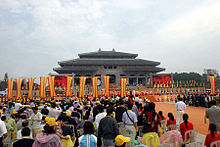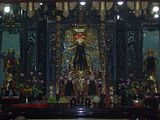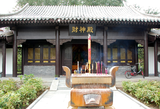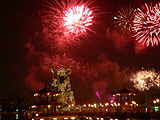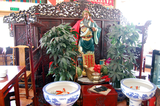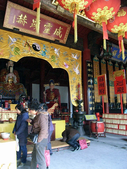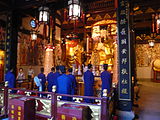- Chinese folk religion
-
Chinese folk religion (traditional Chinese: 中國民間宗教 or 中國民間信仰; simplified Chinese: 中国民间宗教 or 中国民间信仰; pinyin: Zhōngguó mínjiān zōngjiào or Zhōngguó mínjiān xìnyăng) or, controversially, Shenism (pinyin: Shénjiào, 神教)[1][2][3] are labels used to describe the collection of ethnic religious traditions which have been a main belief system in China and among Han Chinese ethnic groups for most of the civilization's history until today. Shenism comprises Chinese mythology and includes the worship of shens (神, shén; "deities", "spirits", "awarenesses", "consciousnesses", "archetypes") which can be nature deities, Taizu or clan deities, city deities, national deities, cultural heroes and demigods, dragons and ancestors. "Shenism" is a term was first published by A.J.A Elliot in 1955,[4] and is described as a misleading terminology among scholars.
It is sometimes considered a type of Taoism, a Folk Taoism, since over the centuries institutional Taoism has been attempting to assimilate or administrate local religions. More accurately, Taoism can be defined as a branch of Shenism, since it sprang out of folk religion and Chinese philosophy. Chinese folk religion is sometimes seen as a constituent part of Chinese traditional religion, but more often, the two are regarded as synonymous. Followers of Chinese folk religion also use Confucianism as an ethical guideline to complement their beliefs, and the two are often confused.[citation needed].
With around 454 million adherents, or about 6.6% of the world population,[5] Chinese folk religion is one of the major religious traditions in the world. In China more than 30% of the population adheres to Shenism or Taoism.[6]
Despite being heavily suppressed during the last two centuries of the history of China, from the Taiping Movement to the Cultural Revolution, it is experiencing a major revival nowadays in both Mainland China and Taiwan.[7][8] Various forms have received support by the Government of the People's Republic of China, such as Mazuism in Southern China (officially about 160 million Chinese are Mazuists),[9] Huangdi worship,[10][11] Black Dragon worship in Shaanxi,[12][13][14] and Caishen worship.[15]
Contents
Overview
Chinese folk religion retains traces of some of ancestral primal religious belief systems such as animism and shamanism,[16][17] which include the veneration of (and communication with) the Sun, the Moon, the Earth, the Heaven, and various stars, as well as communication with animals. It has been practiced by the Chinese people for thousands of years, and since the start of the Common Era alongside Buddhism, Taoism and various other religions.
Rituals, devotional worship, myths sacred reinactment, festivals and various other practices associated with different folk gods and goddesses form an important part of Chinese culture today. The veneration of secondary gods does not conflict with an individual's chosen religion, but is accepted as a complementary adjunct, particularly to Taoism. Some mythical figures in folk culture have been integrated into Chinese Buddhism, as in the case of Miao Shan. She is generally thought to have influenced the beliefs about the Buddhist bodhisattva Guanyin. This bodhisattva originally was based upon the Indian counterpart Avalokiteśvara. Androgynous in India, this bodhisattva over centuries became a female figure in China and Japan. Guanyin is one of the most popular bodishisattvas to which people pray.
There are many free folk religion texts such as Journeys to the Underworld distributed in temples, or sold in gods material shops or vegetarian shops. Temples for Shenist worship are different from Taoist temples and Buddhist monasteries, being administered by local managers, associations and worship communities.
Characteristics
Gods and goddesses
There are hundreds of local gods and goddess as well as demigods. After apotheosis, historical figures noted for their bravery or virtue are also venerated and honored as ancestral "saints", xians, or heightened to the status of shens, deities. The following list represents some commonly worshipped deities.
- Pangu (盘古), the creator god in certain myths. He is usually depicted as a primitive, hairy giant with horns on his head and clad in furs. Pangu set about the task of creating the world: he separated Yin from Yang with a swing of his giant axe, creating the Earth (murky Yin) and the Sky (clear Yang).
- Fuxi (伏羲), also known as Paoxi, a divine patriarch reputed to have taught to humanity writing, fishing, and hunting. Cangjie is also said to have invented writing.
- Nüwa (女娲), also Nügua, an ancient mother goddess, attributed for the creation of mankind. In later traditions she is described as the twin sister or/and wife of Fuxi.
- Shennong (神农), also identified as Yandi (炎帝), a divine patriarch said to have taught the ancient Chinese the practices of agriculture. He is often represented as a human with bull horns.
- Huangdi (黃帝), or "Yellow Emperor", the divine patriarch of the Huaxia culture lineage. He is regarded as the founder of China.
- Guan Yu (关羽), also known with the templar names of Guandi and Guan Gong, the red-faced, bearded hero of Romance of the Three Kingdoms and symbol of loyalty. He is the patron god of policemen, war, fortune, and law, as he shows forgiveness, and often also serves as Wu Sheng.
- Baosheng Dadi (保生大帝), a divine physician, whose powers extend to raising the dead. Worship is especially prevalent in Fujian and Taiwan.
- Caishen (财神 "God of Wealth"), who oversees the gaining and distribution of wealth through fortune. He is often the deified manifestation of certain historical personalities such as Zhao Gongming or Bi Gan. His shape is sometimes that of a giant blue whiskered cat.
- Shoushen (寿神 "God of Longevity"), who stands for a healthy and long life. He is portrayed as an old balding man with a walking stick in his right hand and a peach in his left.
- Fushen (福神 "God of Happiness"), he looks like a traditional Chinese feudal lord with red clothing. He symbolizes happiness and joy.
- Lushen (禄神 "God of Prosperity"), a god of success in work and life. In ancient times he was the patron god of success in imperial bureaucracy.
- The Baxian (八仙), the "Eight Immortals", are important literary and artistic figures who were deified after death and became objects of worship. In Taoism they're worshipped as xians.
- Huye (虎爺), a guardian spirit, often found at the bottom of Taoist temple shrines. Worshipers revere the tiger spirit to curse spiritual enemies. Rituals include stomping an effigy of a spiritual enemy in front of the tiger spirit, as well as sacrificing meat offerings, paper gold, and others.
- The Jiuhuang Dadi (九皇大帝) refer to spirits of nine emperors, worshiped as emanations of Mazu, patron goddess of sailors. A festival is held over the first nine days of the ninth lunar month to celebrate the return from heaven to earth of the Nine Emperor spirits. This is celebrated primarily in Malaysia.
- Mazu (妈祖 "Ancient Mother"), the patroness, also considered as the goddess of sailors. Shrines can be found in coastal areas of Eastern and South-Eastern China. Today, belief in Mazu is especially popular in the South and South-East, including Fujian (福建), Guangdong (廣東), Hainan (海南), Taiwan (台灣), Hong Kong (香港), and Vietnam (越南).
- Qiye (七爺) and Baye (八爺), two generals and best friends, often seen as giant puppets in street parades. 8 is black, because he drowned rather than miss his appointment to meet with 7, even though a flood was coming. 7 has his tongue sticking out, because he hanged himself in mourning for 8.
- Shangdi (上帝) is originally the supreme god, synonymous with the concept of Tian. This title/name was later applied to the supreme deity of various religions, including Yu Huang Dadi and the Christian God.
- Cheng Huang (城隍), commonly known as "City God" in English, a class of protective deities: each city has a Cheng Huang who looks after the fortunes of the city and judges the dead. Usually these are famous or noble persons from the city who were deified after death. The Cheng Huang Miao (城隍廟) or "City God Temple" was often the focal point of a town in ancient times.
- Tudi Gong (土地公 "God of the Earth"), a genius loci who protects a local place (especially hills), and whose statue may be found in roadside shrines. He is also the god of wealth, by virtue of his connection with the earth, and therefore, minerals and buried treasure.
- Wenchangdi (文昌帝), god of students, scholars, and examination. He is worshiped by students who wish to pass their examinations. Inept examiners in ancient times sometimes sought "divine guidance" from him to decide rank between students.
- Xi Wangmu (西王母), the "Queen Mother of the West", also known as Yaochi Jinmu (瑤池金母 "Golden Mother of the Jade Pond"), a mother goddess who reigns over a paradisaical mountain and has the power to make others immortal. In some myths, she is the mother of the Jade Emperor (玉帝).
- Yuexia Laoren (月下老人 "Old Man Under the Moon"). The matchmaker who pairs lovers together, worshiped by those seeking their partner.
- Zaoshen (灶神), the "God of the Kitchen", also Zao Jun (灶君), mentioned in the title of Amy Tan's novel, The Kitchen God's Wife. He reports to heaven on the behavior of the family of the house once a year, at Chinese New Year, and is given sticky rice to render his speech less comprehensible on that occasion.
- Songzi Niangniang (送子娘娘) or Zhusheng Niangniang (註生娘娘), a fertility goddess. She is worshipped by people who want children, or who want their child to be a boy.
Places of worship
Shenist temples can be distinguished into miao (庙), called "joss houses", "deity houses" or simply "temples" in English, and ci (祠), called "ancestral halls" or simply "temples" in English. Both the terms actually mean "temple" in Chinese, and they've been used interchangeably many times. However miao is the general Chinese term for "temple" understood as "place of worship", and can be used for places of worship of any religion. In Chinese folk religion it is mostly associated to temples which enshrine nature gods and patron gods. Instead ci is the specific term for temples enshrining ancestry gods, human beings apotheosized as gods.
"Joss" is a corrupted version of the Portuguese word for "god", deus. "Joss house" was in common use in English in western North America during frontier times, when joss houses were a common feature of Chinatowns. The name "joss house" describes the environment of worship. Joss sticks, a kind of incense, are burned inside and outside of the house.
Shenist temples are distinct from Taoist temples (观 guan or 道观 daoguan) and Buddhist monasteries (寺 si) in that they are established and administered by local managers, associations and worship communities; only few or none priests stay in folk temples. Shenist temples are usually small, very colourful (by contrast with Taoist temples which by tradition should be black and white in color, and Buddhist temples which are characterised by a prevalence of yellow and red tonalities), and decorated with traditional figures on their roofs (dragons and deities), although some evolve into significant structures. Other terms associated to templar structures of Shenism and other religions in China are 宫 gong ("palace"), often used for large temples (even if mostly Taoist) built by imperial officials, and 院 yuan, a general term for "sanctuary", "shrine".
Societal impact
Scholars have studied how Chinese folk religion-inspired society, elastic and polytheistic in spirit, provided the groundwork for the development of dynamic grassroots Chinese-style pre-modern capitalism in Song Dynasty China and modern capitalism in contemporary Taiwan.[18][19][20][21] Chinese folk religion with its ritual economy is also the key of the contemporary economic development in rural Mainland China.[22][23]
Demographics
With around 400 million adherents Chinese folk religion is one of the major religions in the world, comprising about 6% of world population.[24][25] In China more than 30% of the population adheres to Shenism or Taoism. In Taiwan, Shenism is highly institutionalised under the label and the institutions of "Taoism", which is adhered by 33% of the population.[citation needed]
In Singapore about 8.5% of the total population is Taoist, and 10% of the Chinese Singaporeans identify as Taoists.[26] In Malaysia, 10.6% of Chinese Malaysians are Shenists-Taoists, corresponding to 3% of the whole country population. In Indonesia, Taosu Agung Kusumo, leader of the Majelis Agama Tao Indonesia, claims there are 5 million Taoist followers in the country as of 2009.[27]
Gallery
Images of Shenist temples, altars, deity depictions, and practices Paper prayers, candles and offerings on a Taiwanese altarA typical miao altarClothed statues of Mazu (Goddess of the Seas)See also
- Ancestor worship
- Animism
- Chinese mythology
- Chinese creation myth
- Chinese spiritual world concepts
- Feng shui
- Gods material shop
- Religion in China
- Malaysian Chinese religion
- Singaporean Chinese religion
- Tianli/Tengriism
Further reading
- Manchao, Cheng, The Origin of Chinese Deities, Foreign Languages Press, Beijing, 1995. ISBN 7-119-00030-6
- Paper, Jordan D., The Spirits are Drunk: Comparative Approaches to Chinese Religion, Albany, New York : State University of New York Press, 1995. ISBN 0-7914-2315-8
References
- ^ Reinventing Chinese Syncretic Religion: Shenism
- ^ How we came to ‘pai shen’
- ^ Religious Diversity in Singapore
- ^ http://www.highbeam.com/doc/1G1-126163460.html
- ^ Religion. (2011). In Encyclopædia Britannica.
- ^ Chinese Folk Religion Adherents by Country
- ^ Roundtable before the Congressional-Executive Commission on China
- ^ The Upsurge of Religion in China
- ^ China's Leaders Harness Folk Religion For Their Aims
- ^ Over 10,000 Chinese Worship Huangdi in Henan
- ^ Compatriots across the strait honor their ancestry
- ^ Return to folk religions brings about renewal in rural China
- ^ The Policy of Legitimation and the Revival of Popular Religion in Shaanbei, North-Central China
- ^ Miraculous response: doing popular religion in contemporary China
- ^ 苍南金乡玄坛庙成华夏第八财神庙
- ^ http://www.omf.org/omf/uk/asia/religions/animism
- ^ http://website.leidenuniv.nl/~haarbjter/shamanism.htm
- ^ Council of Foreign Relations. Symposium on Religion and the Future of China: Religion, Civil Society, and Economic Life. June 11, 2008.
- ^ Hill Gates - Robert P. Weller. Hegemony of Chinese Folk Ideologies. Sage Publications, 1987.
- ^ Gordon Redding. The Spirit of Chinese Capitalism. Walter de Grutyer, 1990.
- ^ Hill Gates. China's motor: one thousand years of petty-capitalism. Cornell University, 1996.
- ^ Mayfair Mei-hui Yang (Director of Asian Studies, University of Sydney, Australia). Ritual Economy and Rural Capitalism with Chinese Characteristics. University of California Press. Retrieved 31st July 2011.
- ^ Pui-lam Law. The Revival of Folk Religion and Gender Relationships in Rural China. Hong Kong Polytechnic University Press. Retrieved 31st July 2011.
- ^ Major Religions of the World Ranked by Number of Adherents
- ^ How Now Tao
- ^ CIA World Factbook - Singapore
- ^ Tao, Taoism Religion
External links
 Media related to Chinese folk religion at Wikimedia Commons
Media related to Chinese folk religion at Wikimedia CommonsChinese mythology Overview topics Major entities Creatures Bixie · Black Tortoise · Azure Dragon · White Tiger · Vermilion Bird · Qilin · Fenghuang · Huli jing · Chinese guardian lions · Píxiū · NiánPlaces Popular literary works Shan Hai Jing · Shi Yi Ji · The Peach Blossom Spring · Fengshen Bang · Legend of the White Snake · Strange Stories from a Chinese Studio · Journey to the West · In Search of the Supernatural · Zi Bu Yu · Tian Xian PeiCategories:- Religion in China
- Chinese traditional religion
- East Asian religions
- Folk religions
Wikimedia Foundation. 2010.



